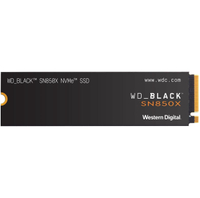DRAM or DRAM-less? Whichever you pick, these are two great 2 TB gaming SSD deals
DRAM-equipped SSDs have the best outright performance but cost a little more. So do you save and go slower, or spend and go blazing?

Nextorage NEM-PAB | 2 TB | NVMe | PCIe 4.0 | 7,300 MB/s read | 6,900 MB/s write | $249.99 $139.99 at Newegg (save $110)
This Nextorage doesn't have any DRAM cache, making it a little less responsive than the DRAM-equipped NEM-PA model, but it's absolutely no slouch though. Prices for this excellent SSD are really volatile but it's still one of the better-value 2 TB drives with a heatsink.
Price check: Amazon $139.99
WD Black SN850X | 2 TB | NVMe | PCIe 4.0 | 7,300 MB/s read | 6,300 MB/s write | $189.99 $144.44 at Amazon (save $45.55)
It's been our favorite SSD for gaming for what seems like a decade or four, but the SN850X is still the best PCIe 4.0 SSD you can buy. Thanks to its healthy DRAM cache, it's a great choice as a boot drive with plenty of space for your game library.
Price check: Newegg $154.98 | Best Buy $159.99
When I'm asked to recommend an SSD, either as a replacement for a boot drive or something to just store games, I generally only ask a few questions first: What's your budget, and do you need to write lots of big files all the time to the drive?
The former will determine what capacity one can get and if it's around the $140 mark, then you're looking at 2 TB of storage. To be honest, that's something I recommend anyway as even 1 TB can fill up very quickly with some of the latest games.
However, the latter is about determining whether the SSD needs to have a DRAM chip. Without going into a long story about how NAND flash storage works, DRAM is only important if you want to have the best performance while writing lots of big files to the drive. I'm not talking about just a few gigabytes here and there, I'm talking hundreds and hundreds, over and over.
In the old days of SSDs, DRAM was required to store the map of where all the data is located on the drive but modern SSDs all support something called Host Memory Buffer (HMB), which stores the map in a small part of your PC's system memory. It's still a little quicker to have it in some RAM local to the SSD but in general, it's now just used to support protracted and heavy writes.
And it's the latter question you need to ask yourself when choosing between these two great SSD deals. The first one is from Nextorage (a storage company that started life as a division of Sony) and is a brilliant drive. We've reviewed the DRAM-equipped version (NEM-PA) and it's blisteringly quick; thanks to the beefy heatsink, it also runs very cool.
This DRAM-less NEM-PAB version is just as speedy but won't be able to sustain that performance when being worked really hard for lengthy periods.
If that scenario is important to you, then for just a few dollars more, the WD Black SN850X is the one to go for. It's been our top choice as the best gaming SSD for a long time and for very good reasons. It's ridiculously fast, runs cool (though that will depend on your motherboard's SSD heatsink), and sucks up pretty much any data writing load you care to throw at it.
My main PC has four of them (one for boot and primary apps, another for development stuff, one for games, and a final one for documents). A tad excessive perhaps but the SN850X is an exceptionally good SSD and I don't regret spending the money one bit.
Both SSDs have been cheaper in the past but at the moment, SSD prices are generally on the higher side as flash manufacturers have been lowering production to improve profit margins. Fortunately, no matter whether you buy the Nextorage NEM-PAB or the WD Black SN850X, you'll have a brilliant SSD in your gaming PC and it'll serve you well for many years to come.
The biggest gaming news, reviews and hardware deals
Keep up to date with the most important stories and the best deals, as picked by the PC Gamer team.

Nick, gaming, and computers all first met in 1981, with the love affair starting on a Sinclair ZX81 in kit form and a book on ZX Basic. He ended up becoming a physics and IT teacher, but by the late 1990s decided it was time to cut his teeth writing for a long defunct UK tech site. He went on to do the same at Madonion, helping to write the help files for 3DMark and PCMark. After a short stint working at Beyond3D.com, Nick joined Futuremark (MadOnion rebranded) full-time, as editor-in-chief for its gaming and hardware section, YouGamers. After the site shutdown, he became an engineering and computing lecturer for many years, but missed the writing bug. Cue four years at TechSpot.com and over 100 long articles on anything and everything. He freely admits to being far too obsessed with GPUs and open world grindy RPGs, but who isn't these days?



